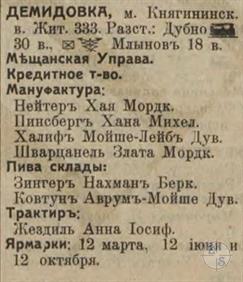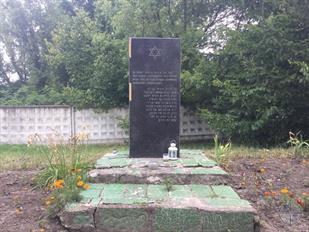Demydivka
Dubno district, Rivne region
Sources:
- Jewish encyclopedia of Brockhaus & Efron;
- Russian Jewish encyclopedia. Translated from Russian by Eugene Snaider;
- The All South-Western Territory: reference and address book of the Kyiv, Podolsk and Volyn provinces. Printing house L.M. Fish and P.E. Wolfson, 1913;
- Yad Vashem. Demidowka
Photo:
- European Jewish Cemeteries Initiative. Holocaust memorial in Demydivka
- Jewish encyclopedia of Brockhaus & Efron;
- Russian Jewish encyclopedia. Translated from Russian by Eugene Snaider;
- The All South-Western Territory: reference and address book of the Kyiv, Podolsk and Volyn provinces. Printing house L.M. Fish and P.E. Wolfson, 1913;
- Yad Vashem. Demidowka
Photo:
- European Jewish Cemeteries Initiative. Holocaust memorial in Demydivka
Demydivka (ukr. Демидівка, rus. Демидовка) urban-type settlement (since 1959) In 18 century in Volyn Voivodeship as part of the Commonwealth. Since 1793 - as part of the Russian Empire. In the 19th - early 20th centuries - the township of Dubno district of the Volyn province. In 1919–39 - in the Volyn Voivodeship as part of Poland, in 1939–91 - as part of the Ukrainian SSR.
In 1847, 377 Jews lived in Demydivka,
in 1897 - 679 (100%),
in 1921 - 592,
in 1931 - approx. 900 Jews.
In the 19th - early 20th centuries Jews made their living from small trade and crafts.
In 1913, Jews owned both beer warehouses and all 4 manufactory shops in the township.
The Jew Sara Ashkenazi was only doctor in the township.
In the 1920-30s there were branches of various Jewish parties and organizations.
Many Zionist parties were active in the town, including their youth organizations (Hashomer Hatzair, HeHalutz Hatzair). A HeHalutz training commune also existed in Demydivka.
The Rabbi in Demydivka in the 1920-30s was David Alperson, who died during the Holocaust.
In 1847, 377 Jews lived in Demydivka,
in 1897 - 679 (100%),
in 1921 - 592,
in 1931 - approx. 900 Jews.
In the 19th - early 20th centuries Jews made their living from small trade and crafts.
In 1913, Jews owned both beer warehouses and all 4 manufactory shops in the township.
The Jew Sara Ashkenazi was only doctor in the township.
In the 1920-30s there were branches of various Jewish parties and organizations.
Many Zionist parties were active in the town, including their youth organizations (Hashomer Hatzair, HeHalutz Hatzair). A HeHalutz training commune also existed in Demydivka.
The Rabbi in Demydivka in the 1920-30s was David Alperson, who died during the Holocaust.
The Germans occupied Demydivka on June 24, 1941. During the first week of the occupation, seven young Jews were shot dead for being members of the Komsomol (the Communist Party youth organization). Shortly afterward, the first requisitions of Jewish property and valuables began. During this time, Jews were ordered to wear distinctive symbols on their clothing.
The Germans established a five-member Judenrat (Jewish council), headed by Eliahu Titelboym, and a Jewish police force.
The local Jews suffered from severe shortages of food. One of the Judenrat's functions was the distribution of the limited supplies of flour it received from the German authorities. However, local Ukrainians robbed the Jews of these flour rations, as well as their money. Forced labor was imposed on the Jews, who were put to work on farms and in peat bogs, while some men were sent to work on the estate of Count Liudochowski in the village of Smordwa.
In the spring of 1942 (or, according to another testimony, in November or December 1941) a ghetto was set up in the town. It was fenced off with boards, and topped with barbed wire.
On October 8, 1942, ghetto was liquidated, and its inmates were shot dead by a German unit at the Griner Grove, outside of town. More than 100 Jews, mainly young ones, were able to avoid this massacre by hiding. Of this number, fifty were found and shot dead in Demydivka, apparently later that same month. Afterward, several dozen more Jews were captured and shot.
The Germans established a five-member Judenrat (Jewish council), headed by Eliahu Titelboym, and a Jewish police force.
The local Jews suffered from severe shortages of food. One of the Judenrat's functions was the distribution of the limited supplies of flour it received from the German authorities. However, local Ukrainians robbed the Jews of these flour rations, as well as their money. Forced labor was imposed on the Jews, who were put to work on farms and in peat bogs, while some men were sent to work on the estate of Count Liudochowski in the village of Smordwa.
In the spring of 1942 (or, according to another testimony, in November or December 1941) a ghetto was set up in the town. It was fenced off with boards, and topped with barbed wire.
On October 8, 1942, ghetto was liquidated, and its inmates were shot dead by a German unit at the Griner Grove, outside of town. More than 100 Jews, mainly young ones, were able to avoid this massacre by hiding. Of this number, fifty were found and shot dead in Demydivka, apparently later that same month. Afterward, several dozen more Jews were captured and shot.

- Home
- Shtetls
- Vinnytsia region
- Volyn region
- Dnipro region
- Donetsk region
- Zhytomyr region
- Zakarpattia region
- Zaporizhzhia region
- Ivano-Frankivsk region
- Kyiv region
- Kropyvnytskyi region
- Luhansk region
- Lviv region
- Mykolayiv region
- Odessa region
- Poltava region
- Rivne region
- Sumy region
- Ternopil region
- Kharkiv region
- Kherson region
- Khmelnytskyi region
- Chernihiv region
- Chernivtsi region
- Cherkasy region
- Crimea
- Synagogues
- Cemeteries
- Objects & guides
- Old photos
- History
- Contact
Jewish towns of Ukraine
My shtetl
My shtetl
Donate
Jewish towns of Ukraine

